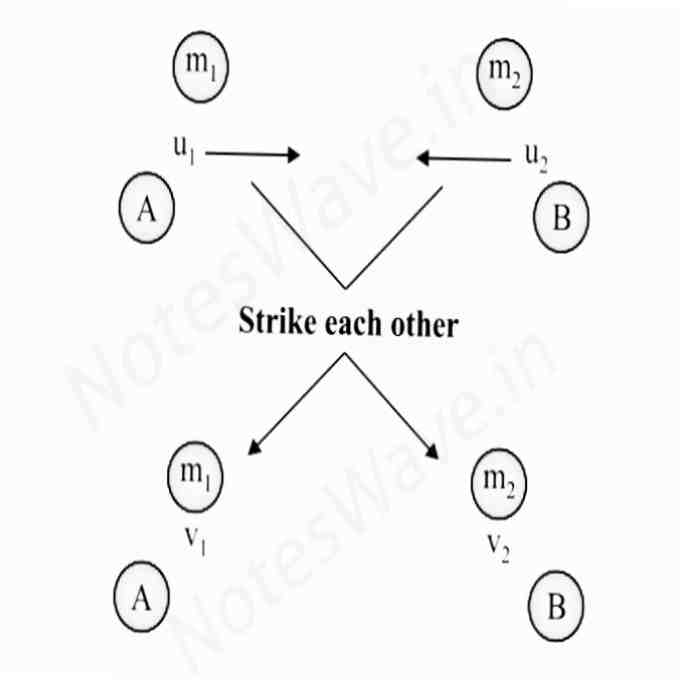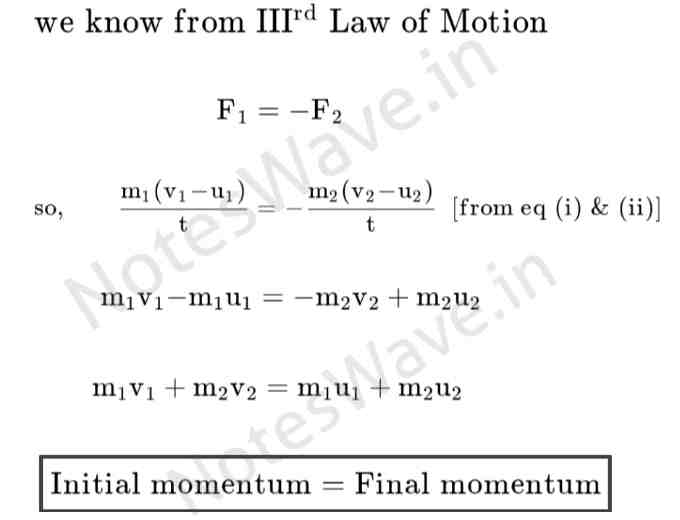| Chapter 8 | Force and Laws of Motion |
| Class | 9th |
| Subject | Science (Physics) |
| Medium | English |
Introduction to Force
A force is an effort that changes the state of an object at rest or at motion. It can change an object’s direction and velocity. Force can also change the shape of an object.
Effects of Force
Some effects of force include the following:
- Force moves stationary objects
- Force stops objects from moving
- Force changes the shape of a body
- Force changes the direction of motion
Balanced Force
If the resultant of applied forces is equal to zero, are called balanced forces.
- Balanced force are equal in magnitude and opposite in direction.
- Balanced force do not cause any change of state of an object.
- Balanced force can change the shape and size of object.
Unbalanced Force
If the resultant of applied forces is not equal to zero, are called unbalanced forces.
Unbalanced forces can:
- Change the speed and position of an object.
- Change the shape and size of an object.
| Balanced Force | Unbalanced Force |
|---|---|
| 1. When two or more forces act on a body and produce a net force equal to zero, the forces are called balanced forces. | 1. When two or more forces act on a body and produce a net force not equal to zero, the forces are called unbalanced forces. |
| 2. A balanced force does not produce any change in the state of uniform motion or rest of the body. | 2. An unbalanced force can produce a change in the state of uniform motion or rest of the body. |
| 3. A balanced force does not cause a body to accelerate. | 3. An unbalanced force can accelerate a body |
| 4. In balanced forces, the forces are equal in magnitude and opposite in direction, canceling each other out. | 4. In unbalanced forces, the forces are unequal in magnitude, causing the object to move in the direction of the greater force. |
Net Force
When multiple forces act on a body, they can be resolved into one component known as the net force acting on the object. The net force decides the direction of motion.
Frictional Force
The force that opposes relative motion is called friction. It arises between the surfaces in contact.Example: When we try to push a table and it does not move is because it is balanced by the frictional force.
Contact Forces
A force applied to an object by touching it physically.
Example: holding, lifting etc.
Non- contact Forces
A force applied to an object without touching it physically.
Example: Magnetic force, Force of Gravitation
Aristotle Fallacy: An external force is required to keep a body in uniform motion.
Galileo Experiment: The law of inertia- inertia is the tendency of a body to remain at rest or in uniform motion.
Inertia
The natural tendency of an object to remain at rest or in motion at a constant speed along a straight line is called inertia.
- The mass of an object is a quantitative measure of inertia.
- More the mass, more will be the inertia of an object and vice-versa.
Inertia of an object can be of three types:
(1) Inertia of rest, the tendency of an object to remain at rest. This means an object at rest remains at rest until a sufficiently large external force is applied on it.
(2) Inertia of motion, the tendency of an object to remain in the state of uniform motion. This means an object in uniform motion remains continue to move uniformly until an external force is applied on it.
(3) Inertia of direction, the tendency of an object to maintain its direction. This means an object moving in a particular direction remains continue to move in that until an external force is applied to change it.
- Inertia of any object is measured by its mass.
- Inertia is directly proportional to mass.
Mass
The Amount of matter contained in a body is called as mass.
- S.I. unit of mass kg.
- It is Scalar quantity.
Q. Why does a person standing in a bus fall backward when the bus suddenly starts moving?
Answer: Initially, both the bus and the person are at rest. When the bus suddenly starts moving, the legs of the person move with the bus, but the upper part of their body tends to remain at rest due to inertia, causing them to fall backward if they are not alert.
Q. Why does a person standing in a moving bus fall forward when the driver suddenly applies the brakes?
Answer: When the bus is moving, the person is also in motion along with it. When the brakes are suddenly applied, the bus slows down or stops abruptly, but the upper part of the person's body tends to remain in motion due to inertia, causing them to fall forward.
Q. Why are seat belts used in cars and other vehicles?
Answer: Seat belts are used to prevent passengers from being thrown forward in case of sudden braking or an accident. When the vehicle stops suddenly, passengers tend to continue moving forward due to inertia, and the seat belt restrains them and prevents injuries.
Q. Why do we give many jerks to wet clothes before hanging them to dry?
Answer: Jerks cause the water droplets in the clothes to separate from the fabric. When the clothes are suddenly moved, the water droplets tend to remain at rest due to inertia and fall out, reducing the water content in the clothes and helping them dry faster.
Q. Why does the coin fall into the glass tumbler when the card is flicked away quickly?
Answer: The coin remains in its state of rest due to inertia. When the card is flicked away quickly, the coin's inertia causes it to stay in place while the card moves, so the coin falls straight down into the tumbler.
Q. Why does water spill when you turn around quickly holding a tray with a water-filled tumbler?
Answer: The water tends to stay in its state of rest due to inertia. When the tray is turned quickly, the water does not follow the motion of the tray immediately, causing it to spill out.
Newton’s first law of motion (Galileo’s law of inertia)
If a body is at rest, it will remain at rest and a body with uniform motion will remain in uniform motion until an external force is applied.
- First Law of Motion is also known as Law of Inertia.
Linear Momentum (Momentum)
The product of mass and velocity of an object is called as momentum.
\overrightarrow{p}=m\overrightarrow{v}
- Momentum increases with increases of either mass or velocity of an object.
- It is vector quantity.
- Momentum is denoted by (p)
- S.I. unit of momentum is kgm/s.
Q. What is the momentum of a body of mass 5 kg moving with a velocity of 0.20 ms-1. [CBSE 2016,2019]
Q. The mass of a goods lorry is 4000 kg and the mass of goods loaded on it is 20,000 kg. If the lorry is moving with a velocity of 2 m/s what will be its momentum ?
Newton’s Second Law of Motion
Newton's second law of motion states that the force exerted on a body is directly proportional to the rate of change of its momentum.
Or
The rate of change of momentum of an object is directly proportional to the applied net unbalanced force in the direction of the force.
Or
Net force acting on a body is directly proportional to the rate of change of its linear momentum.
Mathematical Expression of Newton’s Second Law
$$ F \propto \frac{\text{Change in momentum}}{\text{time}} $$
$$ F \propto \frac{mv – mu}{t} $$
$$ F \propto m \left( \frac{v – u}{t} \right) $$
$$ F \propto ma \Rightarrow F = kma \left( \therefore \frac{v – u}{t} \right) $$
$$ F = ma \left( \therefore k = \text{constant} = 1 \right) $$
The S.I. unit of force is kg ms–2. This is also known as newton and represented by the symbol ‘N’.
1 newton: A force of one newton produces an acceleration of 1 ms–2 on an object.
Question: A force of 20 N acting on a body of mass 10 kg is found to double its velocity in 8 s.Find its initial velocity.
(A) 4 ms–1 (B) 8 ms–1(C) 32 ms–1 (D) 16 ms–1
Q: A person is prone to more serious injuries when falling from a certain height on a hard concrete floor than on a sandy surface. Explain why. [CBSE 2011, 2012, 2015]
Answer: When a person falls from a height on a hard concrete floor, he immediately comes in rest position. It means change in momentum is taking place in an extremely short time and consequently, force exerted by the floor on the person to destroy its momentum is extremely large. Hence, chances of more injuries.When a person falls on a sandy surface, the surface gets compressed downward and it increases the time of fall. As a result for same change in momentum force exerted by sandy surface on the person is less and chances of his being hurt are less.
Q. Why does a continuous push over time help to accelerate a car with a dead battery more effectively than a sudden push?
Answer: Continuous pushing applies a steady force over time, gradually changing the car's momentum, which is more effective than a sudden push that does not provide enough time for momentum change.
Q. Why does a fast-moving cricket ball hurt a spectator more than a table tennis ball hitting a player?
Answer: A fast-moving cricket ball has greater momentum due to its higher mass and velocity, which results in a more forceful impact compared to a table tennis ball.
Q. Why does a fielder pull his hands backwards while catching a fast-moving cricket ball?
Answer: The fielder pulls his hands backward to increase the time over which the ball's momentum decreases to zero. This reduces the acceleration of the ball and thus the force of impact, which helps in reducing the chance of injury.
Q. Why are athletes in high jump events made to fall on cushioned or sand beds?
Answer: Athletes fall on cushioned or sand beds to increase the time over which their momentum decreases to zero. This reduces the rate of change of momentum and thus the force of impact, minimizing the risk of injury.
Q. Why does a karate player use a quick, powerful strike to break a slab of ice?
Answer: A karate player uses a quick, powerful strike to achieve a high acceleration of the fist, which generates a large force over a very short period. This force is sufficient to break the slab of ice despite its resistance.
Q. If the time taken to bring a ball to rest from a certain velocity v is reduced to half,what will be the changes in values of:
(a) initial and final momentum
(b) change of momentum
(c) rate of change of momentum. [CBSE 2012, 2013, 2018]
| Force | Momentum |
|---|---|
| Force = mass × acceleration (F = ma) | Momentum = mass × velocity (p = mv) |
| Forces can exist even when the object is stationary. | Momentum for stationary objects is always zero. |
| The direction of the force depends on the acceleration. | The direction of momentum depends on the direction of velocity. |
| Force is inversely proportional to time (F ∝ 1 / t ) | Momentum is directly proportional to time (p∝ t). |
| Force remains constant for constant acceleration. | Momentum changes with constant acceleration, but remains constant if velocity is constant. |
Newton’s Third Law of Motion
It states that, "when a body exerts force on second body, the second body exerts equal and opposite force on the first body.
In other words, Every ACTION has an equal and opposite REACTION.
\overrightarrow{F}=−\overrightarrow{F}
Q. Why do both players get hurt when they collide while playing football?
Answer: Both players get hurt because, according to Newton's third law, each player exerts an equal and opposite force on the other. These action and reaction forces are equal in magnitude but opposite in direction, resulting in both players feeling the impact.
Q. Why do you push the ground backward when trying to walk forward?
Answer: When you try to walk forward, you push the ground backward. According to Newton's third law, the ground exerts an equal and opposite reaction force on your feet, which propels you forward.
Q. Why does a gun recoil when a bullet is fired?
Answer: When a gun is fired, it exerts a forward force on the bullet, and the bullet exerts an equal and opposite reaction force on the gun. This reaction force causes the gun to recoil backward. The difference in mass between the gun and the bullet results in different accelerations.
Q. Why does a rowing boat move backward when a sailor jumps out of it?
Answer: When a sailor jumps forward from a rowing boat, the force exerted by the sailor on the boat has an equal and opposite reaction force on the boat, causing it to move backward. This demonstrates Newton's third law of motion.
Q. Why does a swimmer push water backward to move forward in the water?
Answer: A swimmer pushes water backward using their arms and legs. According to Newton's third law, the water exerts an equal and opposite force on the swimmer, propelling them forward. The reaction force from the water helps the swimmer move forward in the water.
Q. Why does a rocket move upwards when it is launched?
Answer: A rocket moves upwards because it expels gases downward. According to Newton's third law, the gases push back on the rocket with an equal and opposite force, causing the rocket to accelerate upward.
Q. Why is it difficult to walk on ice compared to a rough surface?
Answer: Walking on ice is difficult because there is less friction between the ice and your shoes. According to Newton's third law, the reaction force you exert on the ice is the same in magnitude but opposite in direction to the friction force, which is much lower on ice than on a rough surface.
Q. Give a reason of the following:
(a) A footballer kicks a ball, which rolls on the ground and after covering some distance comes to rest.
(b) Only the carrom coin at the bottom of a pile is removed when a fast moving striker hits it.
[CBSE 2015, 2018, 2022]
Answer:
(a) When a football is rolling on the ground, a force of friction acts on it due to ground in a direction opposite to its motion. As a result, the motion of football gets slowed down and after covering some distance it comes to rest.
(b) The carrom coin at the bottom of a pile comes in a state of motion due to force exerted by the striker on it. However, other coins of pile remain intact due to their inertia of rest.
Law of Conservation of Momentum
When two (or more) bodies act upon one another, their total momentum remains constant (or conserved) provided no external forces are acting.
Initial momentum = Final momentum
Suppose, two objects A and Be each of mass m₁ and mass m₂ are moving initially with velocities u1 and u₂, strike each other after time t and start moving with velocities v₁ and v₂ respectively



Q. A cricket player catches a ball of mass 0.1 kg moving with a speed of 10 m/s in 0.1 second. What is the force exerted by him?
a) 4 N
b) 2 N
c) 1 N
d) 10 N
Q. When an athlete comes running from a distance, he is able to jump longer. Why? [CBSE 2015, 2017, 2022]
CONSERVATION LAWS
Conservation laws like momentum, energy, angular momentum, and charge are basic rules in physics. They come from observations and experiments. We can't prove these laws, but we can check if they are correct with experiments. If an experiment matches the law, it supports the law. If one experiment doesn't match, it disproves the law.
The law of conservation of momentum has been checked many times over 300 years and always found to be true. This law helps explain many things we see every day.
NCERT Exercise
Q.1. An object experiences a net zero external unbalanced force. Is it possible for the object to be travelling with a non-zero velocity? If yes, state the conditions that must be placed on the magnitude and direction of the velocity. If no, provide a reason.
Answer: Yes, it is possible. An object moving in some direction with constant velocity will continue in its state of motion as long as there are no external unbalanced forces acting on it. In order to change the motion of the object, some external unbalanced force must act upon it.
Q. 2. When a carpet is beaten with a stick, dust comes out of it. Explain.
Answer: We beat a carpet with a stick to remove dust particles. When the carpet is beaten, it is suddenly set into motion. The dust particles which were initially at rest tend to remain at rest due to inertia and hence fall off.When the carpet is beaten with a stick, the stick exerts a force on the carpet which sets it in motion. The inertia of the dust particles residing on the carpet resists the change in the motion of the carpet. Therefore, the forward motion of the carpet exerts a backward force on the dust particles, setting them in motion in the opposite direction. So, the dust comes out of the carpet when beaten.
Q. 3. Why is it advised to tie any luggage kept on the roof of a bus with a rope?
Answer: When some luggage is placed on the roof of a bus which is initially at rest, the acceleration of the bus in the forward direction will exert a force (in the backward direction) on the luggage. In a similar manner, when a bus which is initially in a state of motion suddenly comes to rest due to the application of brakes, a force (in the forward direction) is exerted on the luggage.Depending on the mass of the luggage and the magnitude of the force, the luggage may fall off the bus due to inertia. Tying up the luggage will secure its position and prevent it from falling off the bus.
Q.4. A batsman hits a cricket ball which then rolls on a level ground. After covering a short distance, the ball comes to rest. The ball slows to a stop because
(a) the batsman did not hit the ball hard enough.
(b) velocity is proportional to the force exerted on the ball.
(c) there is a force on the ball opposing the motion.
(d) there is no unbalanced force on the ball, so the ball would want to come to rest.
Answer: When the ball rolls on the flat surface of the ground, its motion is opposed by the force of friction (the friction arises between the ground and the ball). This frictional force eventually stops the ball. Therefore, the correct answer is (c).If the surface of the level ground is lubricated (with oil or some other lubricant), the friction that arises between the ball and the ground will reduce, which will enable the ball to roll for a longer distance.
5. A truck starts from rest and rolls down a hill with a constant acceleration. It travels a distance of 400 m in 20 s. Find its acceleration. Find the force acting on it if it’s mass is 7 tonnes (Hint: 1 tonne = 1000 kg.)
Answer:
6. A stone of 1 kg is thrown with a velocity of 20 ms–1 across the frozen surface of a lake and comes to rest after travelling a distance of 50 m. What is the force of friction between the stone and the ice?
Answer:
7. An 8000 kg engine pulls a train of 5 wagons, each of 2000 kg, along a horizontal track. If the engine exerts a force of 40000 N and the track offers a friction force of 5000 N, then calculate: (a) the net accelerating force and (b) the acceleration of the train.
Answer:
8. An automobile vehicle has a mass of 1500 kg. What must be the force between the vehicle and road if the vehicle is to be stopped with a negative acceleration of 1.7 ms–2?
Answer:
9. What is the momentum of an object of mass m, moving with a velocity v? a. (mv)2. b. mv2. c. ½ mv2. d. mv
Answer: Since momentum is defined as the product of mass and velocity, the correct answer is (d), mv.
10. Using a horizontal force of 200 N, we intend to move a wooden cabinet across a floor at a constant velocity. What is the friction force that will be exerted on the cabinet?
Answer: Since the velocity of the cabinet is constant, its acceleration must be zero. Therefore, the effective force acting on it is also zero. This implies that the magnitude of opposing frictional force is equal to the force exerted on the cabinet, which is 200 N. Therefore, the total friction force is –200 N.
11. Two objects, each of mass 1.5 kg, are moving in the same straight line but in opposite directions. The velocity of each object is 2.5 ms–1 before the collision during which they stick together. What will be the velocity of the combined object after collision?
Answer:
12. According to the third law of motion when we push an object, the object pushes back us with an equal and opposite force. If the object is a massive truck parked along the roadside, it will probably not move. A student justifies this by answering that the two opposite and equal forces cancel each other. Comment on this logic and explain why the truck does not move.
Answer. Since the truck has a very high mass, the static friction between the road and the truck is high. When pushing the truck with a small force, the frictional force cancels out the applied force and the truck does not move. This implies that the two forces are equal in magnitude but opposite in direction (since the person pushing the truck is not displaced when the truck doesn’t move). Therefore, the student’s logic is correct
13. A hockey ball of mass 200 g travelling at 10 ms–1is struck by a hockey stick so as to return it along its original path with a velocity at 5 ms–1. Calculate the magnitude of change of momentum occurred in the motion of the hockey ball by the force applied by the hockey stick.
Answer:
14. A bullet of mass 10 g travelling horizontally with a velocity of 150 m s–1 strikes a stationary wooden block and comes to rest in 0.03 s. Calculate the distance of penetration of the bullet into the block. Also calculate the magnitude of the force exerted by the wooden block on the bullet.
Answer:
15. An object of mass 1 kg travelling in a straight line with a velocity of 10 ms–1 collides with, and sticks to, a stationary wooden block of mass 5 kg. Then they both move off together in the same straight line. Calculate the total momentum just before the impact and just after the impact. Also, calculate the velocity of the combined object.
Answer:
16. An object of mass 100 kg is accelerated uniformly from a velocity of 5 ms–1 to 8 ms–1 in 6 s. Calculate the initial and final momentum of the object. Also, find the magnitude of the force exerted on the object.
Answer:
17. Akhtar, Kiran, and Rahul were riding in a motorcar that was moving with a high velocity on an expressway when an insect hit the windshield and got stuck on the windscreen. Akhtar and Kiran started pondering over the situation. Kiran suggested that the insect suffered a greater change in momentum as compared to the change in momentum of the motorcar (because the change in the velocity of the insect was much more than that of the motorcar). Akhtar said that since the motorcar was moving with a larger velocity, it exerted a larger force on the insect. And as a result the insect died. Rahul while putting an entirely new explanation said that both the motorcar and the insect experienced the same force and a change in their momentum. Comment on these suggestions.
Answer: Kiran’s suggestion is correct. The mass of the insect is very small when compared to the mass of the car. As per the law of conservation of momentum, the total momentum before the collision between the insect and the car is equal to the total momentum after the collision. Therefore, the change in the momentum of the insect is much greater than the change in momentum of the car (since force is proportional to mass).Akhtar’s suggestion is also correct. Since the mass of the car is very high, the force exerted on the insect during the collision is also very high. Rahul’s suggestion is partially correct. As per the third law of motion, the force exerted by the insect on the car is equal and opposite to the force exerted by the car on the insect. However, Rahul’s suggestion that the change in the momentum is the same contradicts the conservation of momentum.
18. How much momentum will a dumb-bell of mass 10 kg transfer to the floor if it falls from a height of 80 cm? Take its downward acceleration to be 10 ms–2.
Answer:
Question 1. Name the scientist who proved for the first time that objects move with constant speed when no force acts on them.
Answer: Galileo.
Question 2. Why do bicycles begin to slow down when we stop pedalling?
Answer: This is because of the frictional forces acting opposite to the direction of motion.
Question 3. Which law of motion gives the measure of force?
Answer: Newton’s second law of motion.
Question 4. Write the C.G.S unit of force.
Answer: dyne.
Question 5. Can every force produce motion in every object?
Answer: No.
Question 6. When a force is applied to a body, what are the two essential effects it can produce?
Answer: It can bring about a change in the state of motion of a body or It can deform a body, i.e., it can change its shape.
Question 7.Define 1 newton force.
Answer: 1 newton is the magnitude of force that produces an acceleration of 1 m/s2 in a body of mass 1 kg.
Question 8. What do you mean by an impact force?
Answer: The force produced by the impact of a fast-moving object on another is called impact force.
Question 9. Define force of friction.
Answer: The force acting between any two surfaces in contact and tending to oppose motion is called force of friction.
Question 10. Define electrostatic force.
Answer: The force exerted by an electrically charged body is called electrostatic force.
Question 11. If the body is found to be accelerated, is the force acting on it balanced or unbalanced?
Answer: Unbalanced.
Question 19. What is the total momentum of a bullet and a gun before firing?
Answer: Zero.
Question 20. Name the principle on which a rocket works.
Answer: Newton’s third law of motion
Question 21. What is the ratio of SI units to CGS units of momentum? How do you measure the effect of an impulsive force on the body?
Answer: A ratio of SI units to CGS units of momentum is (kg m/s)/(g cm/s) i.e., 10s.The effect of an impulse force on the body is measured only in terms of impulse.
Question 22. On which factors does friction depend?
Answer: The force of friction is directly proportional to the weight of the body sliding over the surface. The force of friction also depends on the nature of the surfaces in contact.
Question 23. A bullet fired against a glass window pane makes a hole in it, and the glass pane is not cracked. But on the other hand, when a stone strikes the same glass pane, it gets smashed. Why is it so?
Answer: When the bullet strikes the glass pane, the part of the glass pane which comes in contact with the bullet immediately shares the large velocity of bullet and makes a hole, while the remaining part of the glass remains at rest and is therefore not smashed due to inertia of rest.But when a slow-moving stone strikes the same glass pane, the various parts of the glass pane get enough time to share the velocity of the stone, and the glass is smashed.
Question 24. Why can a small mass such as a bullet kill a person when fired from a gun?
Answer: It is so because even if the mass of the bullet is small, it moves out of the gun with a very high velocity, due to which the momentum produced is high (p = mv). This high momentum of the bullet kills a person.
Question 25. Why does a boat tend to leave the shore, when passengers are alighting from it?
Answer: When the passengers alight from the boat, they push the boat in the backward direction. As a result, the boat has a tendency to slip back into the water. This difficulty is usually overcome by the boatman by tying the boat to some rigid support.
Question 26. Describe our walking in terms of Newton’s third law of motion.
Answer: When we walk on the ground or road, our foot pushes the ground backward (action) and the ground pushes our foot forward (reaction). Thus, the forward reaction exerted by the ground on our foot makes us walk forward.
Question 27. There are three solids made up of aluminium, steel, and wood, of the same shape and same volume. Which of them would have the highest inertia?
Answer: Steel has the highest inertia. As the mass is a measure of inertia, the ball of the same shape and size, having more mass than other balls will have the highest inertia. Since steel has the greatest density and greatest mass, therefore, it has the highest inertia.
Question 28. Why does a cricket player move his hand backward while catching the ball?
Answer: A fast-moving cricket ball has a large momentum. In stopping or catching this ball, its momentum has reduced to be zero. Now, when a cricket player moves back his hands on catching the fastball, then the time taken to reduce the momentum of the ball to zero is increased. Due to more time taken to stop the ball, the rate of change of momentum of the ball is decreased and hence a small force is exerted on the hands of the player. So, the hands of the player do not get hurt.
Question 29. Two identical bullets are fired one by a light rifle and the other by a heavy rifle with the same force. Which rifle will hurt the shoulder more and why?
Answer: According to the conservation of momentum, the rifle recoils with the same momentum as that of the bullet. As momentum = mass X velocity; so light rifle will recoil with a larger velocity and hence, will hurt the shoulder more.
Question 30. The water sprinkler used for grass lawns begins to rotate as soon as the water is supplied. Explain the principle on which it works.
Answer: The working of the rotation of the sprinkler is based on the third law of motion. As the water comes out of the nozzle of the sprinkler, an equal and opposite reaction force comes into play. So the sprinkler starts rotating.
NUMERICALS FOR PRACTICE
Q.1. A bullet with a mass of 10 g is fired from a rifle. The bullet takes 0.004 seconds to move through the barrel and leaves it with a velocity of 400 m/s. Calculate the force exerted on the bullet by the rifle. [CBSE 2018, 2022]
Q.2. (a) State the reason why a bullet of small mass fired from a gun can be fatal.
(b) A bullet with a mass of 4 g is fired with a velocity of 50 m/s and penetrates a wall to a depth of 10 cm. Calculate the average resistance offered by the wall.
(c) How will the depth of penetration into the wall change if a bullet of mass 5 g strikes it with a velocity of 40 m/s? Provide a reason to justify your answer. [2016, 2018, 2022]
Q.3. Name the physical quantities corresponding to the following units: (i) kgms-2 (ii) N (iii) ms-2 (iv) ms-1
Q.4. An object of mass 50 kg is accelerated uniformly from a velocity of 4 m/s to 8 m/s in 8 seconds. Calculate the initial and final momentum of the object. Also, find the magnitude of the force exerted on the object. [CBSE 2015, 2018, 2023]
Q 5. A body starts from rest and rolls down a hill with a constant acceleration. If it travels 400 m in 20 seconds calculate the force acting on the body if its mass is 10 kg.
Q.6. A hammer of mass 500 g, moving at 50 ms–1, strikes a nail. The nail stops the hammer in a very short time of 0.01 s. What is the force of the nail on the hammer?





